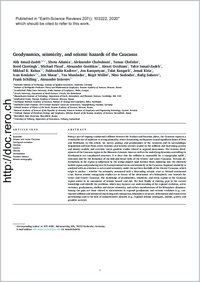Geodynamics, seismicity, and seismic hazards of the Caucasus
- Ismail-Zadeh, Alik Karlsruhe Institute of Technology, Institute of Applied Geosciences, Karlsruhe, Germany - Institute of Earthquake Prediction Theory and Mathematical Geophysics, Russian Academy of Sciences, Moscow, Russia
- Adamia, Shota Javakhishvili Tbilisi State University, Nodia Institute of Geophysics, Tbilisi, Georgia
- Chabukiani, Aleksandre Javakhishvili Tbilisi State University, Nodia Institute of Geophysics, Tbilisi, Georgia
- Chelidze, Tamaz Javakhishvili Tbilisi State University, Nodia Institute of Geophysics, Tbilisi, Georgia
- Cloetingh, Sierd Utrecht University, Department of Earth Sciences, Utrecht, the Netherlands
- Floyd, Michael Massachusetts Institute of Technology, Department of Earth, Atmospheric and Planetary Sciences, Cambridge, MA, USA
- Gorshkov, Alexander Institute of Earthquake Prediction Theory and Mathematical Geophysics, Russian Academy of Sciences, Moscow, Russia
- Gvishiani, Alexei Geophysical Center, Russian Academy of Sciences, Moscow, Russia
- Ismail-Zadeh, Tahir Azerbaijan National Academy of Sciences, Institute of Geology and Geophysics, Baku, Azerbaijan
- Kabanh, Mikhail K. Schmidt Institute of Physics of the Earth, Russian Academy of Sciences, Moscow, Russia
- Kadirov, Fakhraddin Azerbaijan National Academy of Sciences, Institute of Geology and Geophysics, Baku, Azerbaijan
- Karapetyan, Jon National Academy of Sciences of the Republic of Armenia, Nazarov Institute of Geophysics and Engineering Seismology, Gyumri, Armenia
- Kangarli, Talat Azerbaijan National Academy of Sciences, Institute of Geology and Geophysics, Baku, Azerbaijan
- Kiria, Jemal Javakhishvili Tbilisi State University, Nodia Institute of Geophysics, Tbilisi, Georgia
- Koulakov, Ivan Trofimuk Institute of Petroleum Geology and Geophysics, Siberian Branch of the Russian Academy of Sciences, Novosibirsk, Russia - Novosibirsk State University, Novosibirsk, Russia
- Mosar, Jon University of Fribourg, Department of Geosciences, Fribourg, Switzerland
- Mumladze, Tea Javakhishvili Tbilisi State University, Nodia Institute of Geophysics, Tbilisi, Georgia
- Müller, Birgit Karlsruhe Institute of Technology, Institute of Applied Geosciences, Karlsruhe, Germany
- Sadradze, Nino Javakhishvili Tbilisi State University, Nodia Institute of Geophysics, Tbilisi, Georgia
- Safarov, Rafig Azerbaijan National Academy of Sciences, Institute of Geology and Geophysics, Baku, Azerbaijan
- Schilling, Frank Karlsruhe Institute of Technology, Institute of Applied Geosciences, Karlsruhe, Germany
- Soloviev, Alexander Institute of Earthquake Prediction Theory and Mathematical Geophysics, Russian Academy of Sciences, Moscow, Russia
-
01.08.2020
Published in:
- Earth-Science Reviews. - 2020, vol. 207, p. 103222
English
Being a part of ongoing continental collision between the Arabian and Eurasian plates, the Caucasus region is a remarkable site of moderate to strong seismicity, where devastating earthquakes caused significant losses of lives and livelihood. In this article, we survey geology and geodynamics of the Caucasus and its surroundings; magmatism and heat flow; active tectonics and tectonic stresses caused by the collision and shortening; gravity and density models; and overview recent geodetic studies related to regional movements. The tectonic development of the Caucasus region in the Mesozoic-Cenozoic times as well as the underlying dynamics controlling its development are complicated processes. It is clear that the collision is responsible for a topographic uplift / inversion and for the formation of the fold-and-thrust belts of the Greater and Lesser Caucasus. Tectonic deformations in the region is influenced by the wedge-shaped rigid Arabian block indenting into the relatively mobile region and producing near N-S compressional stress and seismicity in the Caucasus. Regional seismicity is analysed with an attention to sub-crustal seismicity under the northern foothills of the Greater Caucasus, which origin is unclear – whether the seismicity associated with a descending oceanic crust or thinned continental crust. Recent seismic tomography studies are in favour of the detachment of a lithospheric root beneath the Lesser and Greater Caucasus. The knowledge of geodynamics, seismicity, and stress regime in the Caucasus region assists in an assessment of seismic hazard and risk. We look finally at existing gaps in the current knowledge and identify the problems, which may improve our understanding of the regional evolution, active tectonics, geodynamics, shallow and deeper seismicity, and surface manifestations of the lithosphere dynamics. Among the gaps are those related to uncertainties in regional geodynamic and tectonic evolution (e.g., continental collision and associated shortening and exhumation, lithosphere structure, deformation and strain-stress partitioning) and to the lack of comprehensive datasets (e.g., regional seismic catalogues, seismic, gravity and geodetic surveys).
- Faculty
- Faculté des sciences et de médecine
- Department
- Département de Géosciences
- Language
-
- English
- Classification
- Geology
- License
-
License undefined
- Identifiers
-
- RERO DOC 328922
- DOI 10.1016/j.earscirev.2020.103222
- Persistent URL
- https://folia.unifr.ch/unifr/documents/308816
Statistics
Document views: 208
File downloads:
- pdf: 825
